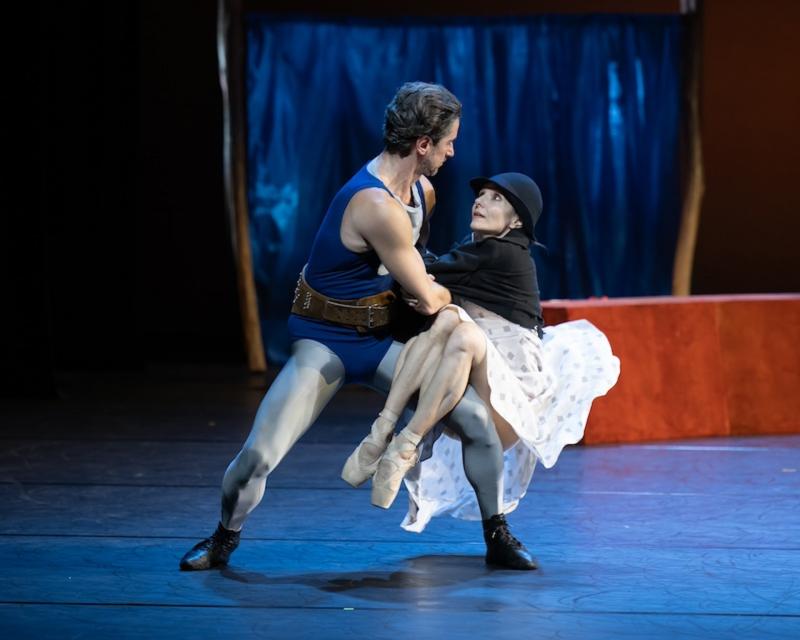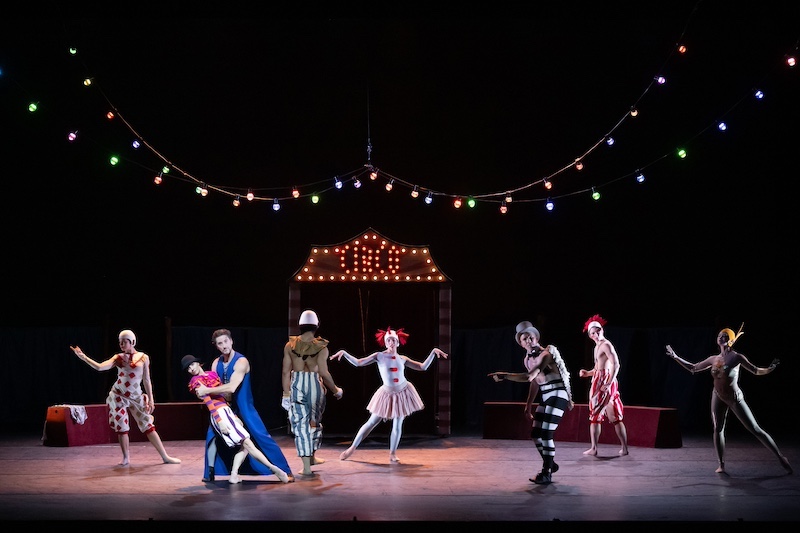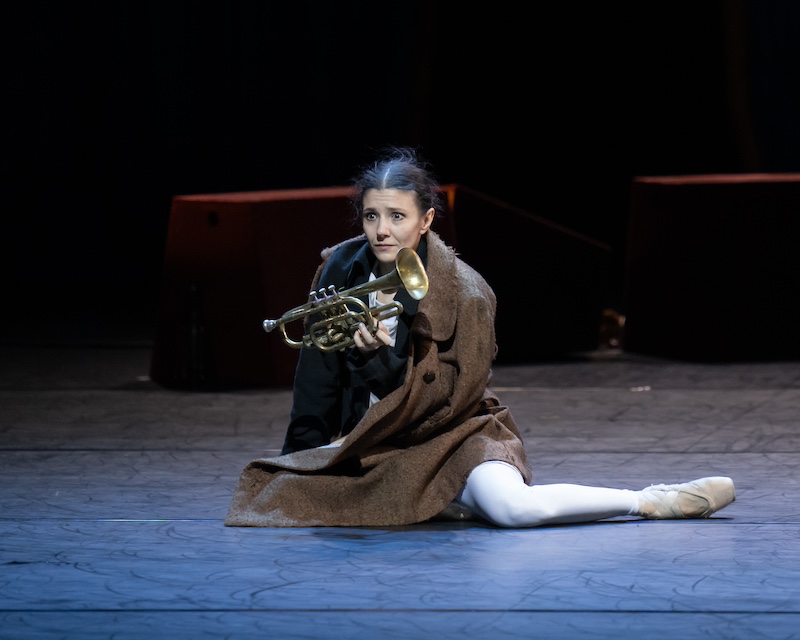La Strada, Sadler's Wells review - a long and bumpy road | reviews, news & interviews
La Strada, Sadler's Wells review - a long and bumpy road
La Strada, Sadler's Wells review - a long and bumpy road
Even the exceptional talents of Alina Cojocaru can't save dance adaptation of Fellini film

Federico Fellini’s 1954 classic La Strada ought to be a gift to a choreographer. The film has pathos, good and evil, a bewitchingly gamine heroine, and incidental music by the great Nino Rota, a composer who can find melancholy in the music of carnival and joy in a tragic trumpet solo – a composer who makes you think “Italy” in every phrase.
Not that the show doesn’t contain many pleasingly fluid sequences of dance, which sometimes soar. Choreographer Natalia Horečná knows her craft and exploits the extraordinary capabilities of her star, Alina Cojocaru (who commissioned this project), with flair (Main picture: Alina Cojocaru with Mick Zeni). But her loose filleting of Fellini’s narrative, far from finding the film’s beating heart, ends up making something quite alien, full of unforeseen stops and detours, and multiple bumps in the road. One of its problems, oddly enough, is the music. Although Nino Rota himself assembled some of his film scores to make a short ballet suite he called La Strada, this isn’t it. Most of the music in Horečná’s dance adaptation comes from other films, including the ballroom scenes in The Leopard, which of course is by Visconti, not Fellini, and a film about Italy’s glossy aristocracy, not its desperate, post World War Two poor. The plot of Fellini’s La Strada is a harsh, dark fairytale, like something the Brothers Grimm might have written. Gelsomina, a young girl, still a child, is sold by her widowed mother to an itinerant circus strongman, Zampano – a depressive, violent loner whose purpose in taking on Gelsomina is never entirely clear. Is she to fill the role of cook, concubine, or strongman’s assistant? Most likely, given Zampano’s vagrancy, criss-crossing the dusty wastes of southern Italy on a beaten-up motorbike-cum-waggon, he simply wants her to keep him warm at night.
One of its problems, oddly enough, is the music. Although Nino Rota himself assembled some of his film scores to make a short ballet suite he called La Strada, this isn’t it. Most of the music in Horečná’s dance adaptation comes from other films, including the ballroom scenes in The Leopard, which of course is by Visconti, not Fellini, and a film about Italy’s glossy aristocracy, not its desperate, post World War Two poor. The plot of Fellini’s La Strada is a harsh, dark fairytale, like something the Brothers Grimm might have written. Gelsomina, a young girl, still a child, is sold by her widowed mother to an itinerant circus strongman, Zampano – a depressive, violent loner whose purpose in taking on Gelsomina is never entirely clear. Is she to fill the role of cook, concubine, or strongman’s assistant? Most likely, given Zampano’s vagrancy, criss-crossing the dusty wastes of southern Italy on a beaten-up motorbike-cum-waggon, he simply wants her to keep him warm at night.
The ballet offers no clue to the harsh landscapes of the film, so important to its sense of poverty and desolation. It struggles even to depict Zampano’s solitariness, magnifying the very brief section of the film in which he and Gelsomina attach themselves to a troupe of circus artistes to the extent that it takes up most of the show. These hyperactive performers (pictured above) help fill the stage and busy the eye, but fatally weaken the story. The single important character among them is Il Matto (Johan Kobborg), a tightrope walker who we only ever see on a unicycle. His kindness to Gelsomina (pictured below) provokes the strongman (Mick Zeni) into a jealous rage, but before Il Matto comes to a sticky end, there is some exciting choreography for the three of them. The superlative quality of these three dance-actors is almost enough to save the show.
 Aware perhaps of a paucity of plot, the choreographer adds an element of mysticism in the form of a pair of angels who appear only to Gelsomina and help her in her darkest hours. This will puzzle those who know Fellini’s film as much as those who don’t. These asexual beings (Marc Jubete and David Rodriguez) perform the useful dance function of enabling Cojocaru to soar and float, skilfully held aloft by them, bestowing her goodness on a wicked world. Her floating is a lovely effect, if overused throughout the ballet. And although there are no angels in Fellini’s film, angels do have form in Italian neo-realist cinema, not least in Vittorio De Sica’s fantasy film Miracle in Milan, which appeared only two years before La Strada.
Aware perhaps of a paucity of plot, the choreographer adds an element of mysticism in the form of a pair of angels who appear only to Gelsomina and help her in her darkest hours. This will puzzle those who know Fellini’s film as much as those who don’t. These asexual beings (Marc Jubete and David Rodriguez) perform the useful dance function of enabling Cojocaru to soar and float, skilfully held aloft by them, bestowing her goodness on a wicked world. Her floating is a lovely effect, if overused throughout the ballet. And although there are no angels in Fellini’s film, angels do have form in Italian neo-realist cinema, not least in Vittorio De Sica’s fantasy film Miracle in Milan, which appeared only two years before La Strada.
While I very much wanted to like this show, it has too many longueurs and lacunae. And for all its cavorting circus people (including a distracting babe in a glittery bikini who seems to have strayed off the set of La Dolce Vita), it fails to capture that special wistful quality that pervades many of Fellini’s films, as well as the films of his contemporaries. In a devastated 1950s Italy, it’s a wistfulness for a past of love and laughter, a memory of carnivals long gone by, and for two centuries before that, the commedia. It’s what makes Italian cinema what it is, and this ballet doesn’t get anywhere close.
rating
Explore topics
Share this article
more Dance
 All You Need Is Death review - a future folk horror classic
Irish folkies seek a cursed ancient song in Paul Duane's impressive fiction debut
All You Need Is Death review - a future folk horror classic
Irish folkies seek a cursed ancient song in Paul Duane's impressive fiction debut
 MacMillan Celebrated, Royal Ballet review - out of mothballs, three vintage works to marvel at
Less-known pieces spanning the career of a great choreographer underline his greatness
MacMillan Celebrated, Royal Ballet review - out of mothballs, three vintage works to marvel at
Less-known pieces spanning the career of a great choreographer underline his greatness
 Carmen, English National Ballet review - lots of energy, even violence, but nothing new to say
Johan Inger's take on Carmen tries but fails to make a point about male violence
Carmen, English National Ballet review - lots of energy, even violence, but nothing new to say
Johan Inger's take on Carmen tries but fails to make a point about male violence
 WAKE, National Stadium, Dublin review - a rainbow river of dance, song, and so much else
THISISPOPBABY serves up a joyous tapestry of Ireland contemporary and traditional
WAKE, National Stadium, Dublin review - a rainbow river of dance, song, and so much else
THISISPOPBABY serves up a joyous tapestry of Ireland contemporary and traditional
 Swan Lake, Royal Ballet review - grand, eloquent, superb
Liam Scarlett's fine refashioning returns for a third season, and looks better than ever
Swan Lake, Royal Ballet review - grand, eloquent, superb
Liam Scarlett's fine refashioning returns for a third season, and looks better than ever
 First Person: Ten Years On - Flamenco guitarist Paco Peña pays tribute to his friend, the late, great Paco de Lucía
On the 10th anniversary of his death, memories of the prodigious musician who broadened the reach of flamenco into jazz and beyond
First Person: Ten Years On - Flamenco guitarist Paco Peña pays tribute to his friend, the late, great Paco de Lucía
On the 10th anniversary of his death, memories of the prodigious musician who broadened the reach of flamenco into jazz and beyond
 Dance for Ukraine Gala, London Palladium review - a second rich helping of international dancers
Ivan Putrov's latest gala was a satisfying mix of stars and young hopefuls
Dance for Ukraine Gala, London Palladium review - a second rich helping of international dancers
Ivan Putrov's latest gala was a satisfying mix of stars and young hopefuls
 Nelken: A Piece by Pina Bausch, Sadler's Wells review - welcome return for an indelible classic
A new generation of gifted performers for us to get to know
Nelken: A Piece by Pina Bausch, Sadler's Wells review - welcome return for an indelible classic
A new generation of gifted performers for us to get to know
 Dark With Excessive Bright, Royal Ballet review - a close encounter with dancers stripped bare
The Royal's Festival of New Choreography launches with an unforgettable walk in the dark
Dark With Excessive Bright, Royal Ballet review - a close encounter with dancers stripped bare
The Royal's Festival of New Choreography launches with an unforgettable walk in the dark
 La Strada, Sadler's Wells review - a long and bumpy road
Even the exceptional talents of Alina Cojocaru can't save dance adaptation of Fellini film
La Strada, Sadler's Wells review - a long and bumpy road
Even the exceptional talents of Alina Cojocaru can't save dance adaptation of Fellini film
 First Person: pioneering juggler Sean Gandini reflects on how the spirit of Pina Bausch has infiltrated his work
As Tanztheater Wuppertal Pina Bausch's 'Nelken' comes to Sadler’s Wells, a tribute from across the art forms
First Person: pioneering juggler Sean Gandini reflects on how the spirit of Pina Bausch has infiltrated his work
As Tanztheater Wuppertal Pina Bausch's 'Nelken' comes to Sadler’s Wells, a tribute from across the art forms
 Manon, Royal Ballet review - a glorious half-century revival of a modern classic
Fifty years on, Kenneth MacMillan's crash-and-burn anti-heroine is riding high
Manon, Royal Ballet review - a glorious half-century revival of a modern classic
Fifty years on, Kenneth MacMillan's crash-and-burn anti-heroine is riding high

Add comment